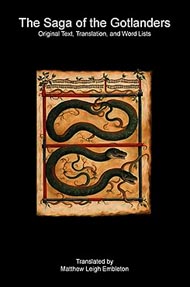The Saga of the Gotlanders
Original Text, Translation, and Word Lists
Matthew Leigh Embleton
Published by Matthew Leigh Embleton, 2021
The Saga of the Gotlanders gives an account of how Gotland was discovered and
populated, their peace treaty with the King of Sweden and annual tribute, and Olaf II
of Norway's visit to Gotland, and its conversion to the Christian faith. The Gutasaga is
believed to have been written in the 13th century, and makes up most of what we
know about Old Gutnish.
What is particularly interesting about the Gutasaga is that it preserves a variety of
Old Norse known as Old Gutnish. This variety of Old Norse is believed to have
evolved in the 7th century along with Old East Norse and Old West Norse.
The meaning of the word 'saga' (plural: 'sogur' or 'sögur') translates as 'that which is said',
or more widely: a 'saying', 'statement', 'story', 'tale', or 'narrative'.
The text is presented in its original Norse, with a literal word-for-word line-by-line
translation, and a Modern English translation, all side-by-side. In this way, it is
possible to see and feel how the Norse language worked and how it has evolved.
Also included is a word list with 1,112 Norse words translated in to English, and 1,119
English words translated into Norse.
This book is designed to be of use and interest to anyone with a passion for the Old
Norse or Old Icelandic language, Norse history, or languages and history in general.
Matthew Leigh Embleton is a language and history enthusiast, musician, composer, and producer
living in London.
(The text above comes from the back of the book)



